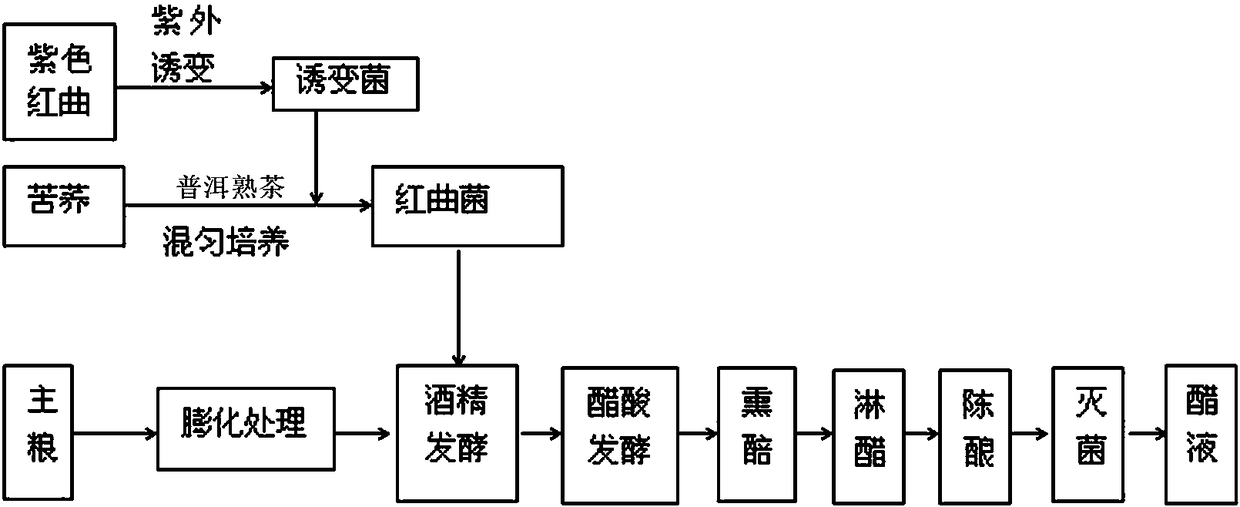Method for brewing lipid-lowering vinegar
A technology of vinegar and vinegar fermented grains, which is applied in the preparation of vinegar, pharmaceutical formulations, medical preparations containing active ingredients, etc., and can solve the problems of inability to reduce blood fat and health-care vinegar, poor lipid-lowering effect of tea vinegar, and use of seasonings, etc. problem, to achieve the effect of improving health function and added value, improving health function, and reducing fat
- Summary
- Abstract
- Description
- Claims
- Application Information
AI Technical Summary
Problems solved by technology
Method used
Image
Examples
Embodiment 1
[0021] Example 1: Naked oats, quinoa and sorghum with a weight ratio of 1:1:1 are the main grains, and rice bran, rice husk, bran and oyster mushrooms are used as auxiliary materials with a weight ratio of 1:1:1.2:3.57 , tartary buckwheat and Pu'er cooked tea are mixed in a ratio of 10:2.5 by weight as a red yeast fermentation substrate, and the purple red yeast rice numbered CICC: 41601 is used as a fermentation strain to ferment Monascus, staple food, and Monascus by weight Ratio of 1:0.625 is mixed for alcoholic fermentation, and the obtained wine mash is mixed with auxiliary materials with a weight ratio of 1:1 to the main grain to form vinegar grains, inoculated with 12%-15% of the weight of vinegar grains with acetic acid bacteria for acetic fermentation, and then smoked Fermented grains, drenched grains to obtain fat-reducing vinegar.
[0022] Specific steps are as follows:
[0023] (1) Preparation of Monascus: remove impurities from tartary buckwheat, soak in water at...
experiment example 1
[0028] Experimental Example 1: Preparation of Monascus
[0029] Add 10kg of tartary buckwheat to warm water (40°C) after removing impurities, soak for 2 hours, remove the dry matter, cook for 30 minutes, add 15% of purple red yeast rice and 25% of raw materials of Pu’er cooked tea after cooling, mix well and place in Quchi, under the condition of 28-32 ℃, culture for about 10-12 days, you can get Monascus, and the lovastatin content reaches 2.01g / 100g. The detection method of lovastatin is detected with reference to the determination method of total amount of lovastatin in red yeast rice (the determination method of total amount of lovastatin in red yeast rice, Luo Rencai, Sun Kaiqi, Xie Shenmeng, Han Ying, Zhao Yanping, Health Research, 2003, 32 , 2, 157-158).
experiment example 3
[0030] Experimental Example 3: Alcoholic Fermentation and Acetic Fermentation Processes
[0031] Alcoholic fermentation raw materials and proportions: naked oats 3.33 kg, quinoa 3.33 kg, sorghum 3.33 kg, tartary buckwheat red yeast rice 6.25 kg, water 30 kg, carry out alcohol fermentation, alcohol fermentation is completed to obtain wine mash, and then mix according to the formula in Table 1 Fermented grains, the alcohol content of vinegar grains is 4.2~4.5, the moisture content is 63%~66%, the temperature is controlled at 30~32°C for acetic fermentation, the fermentation time is 8 days, and the fermented grains are turned 1-2 times a day; smoked after the acetic fermentation is completed Fermented grains, drenched in vinegar, soak 40% of the fermented grains in vinegar for 8-12 hours before pouring vinegar into the top grains, soak the smoked grains of vinegar in the top grains after pasteurization, and pour them out after 4 hours to become vinegar liquid. This experiment set...
PUM
 Login to View More
Login to View More Abstract
Description
Claims
Application Information
 Login to View More
Login to View More - R&D
- Intellectual Property
- Life Sciences
- Materials
- Tech Scout
- Unparalleled Data Quality
- Higher Quality Content
- 60% Fewer Hallucinations
Browse by: Latest US Patents, China's latest patents, Technical Efficacy Thesaurus, Application Domain, Technology Topic, Popular Technical Reports.
© 2025 PatSnap. All rights reserved.Legal|Privacy policy|Modern Slavery Act Transparency Statement|Sitemap|About US| Contact US: help@patsnap.com



